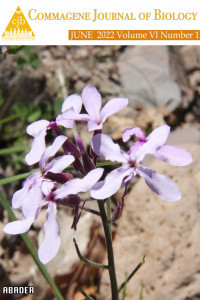Metilparabenin Drosophila melanogaster’in Gelişimi ve Fekunditesi Üzerine Etkileri
Paraben, , endokrin bozucular, endokrin bozucular, endokrin bozucular, gelişim zamanı gecikmesi, yavru döl sayısı, yumurta sayısı
The Effect of Methylparaben on Development and Fecundity of Drosophila melanogaster
Paraben, endocrine disrupting compounds, developmental delay, offspring number, egg number,
___
- Ashburner, M., Golic, K., & Hawley, R.S. (2011). Drosophila a laboratory handbook. New York, Cold Harbor Spring Laboratory Press, 1440pp.
- Ayar, A. & Uysal, H. (2013). Genotoxic and safety assessment of 2 parabens in somatic cells of in vivo Drosophila melanogaster. Turkish Journal of Biology, 37, 683-688. https://doi.org/10.3906/biy-1303-60
- Boberg, J., Taxvig, C., Christiansen, S., & Hass, U. (2010). Possible endocrine disrupting effects of parabens and their metabolites. Reproductive Toxicology (Elmsford, N.Y.), 30(2), 301–312. https://doi.org/10.1016/j.reprotox.2010.03.011
- Chen, Q., Pan, C., Li, Y., Zhang, M., & Gu, W. (2016). The Combined Effect of Methyl- and Ethyl-Paraben on Lifespan and Preadult Development Period of Drosophila melanogaster (Diptera: Drosophilidae). Journal of Insect Science, 16(1), 15. https://doi.org/10.1093/jisesa/iev146
- Gáliková, M., Klepsatel, P., Senti, G., & Flatt, T. (2011). Steroid hormone regulation of C. elegans and Drosophila aging and life history. Experimental Gerontology, 46(2-3), 141–147. https://doi.org/10.1016/j.exger.2010.08.021
- Gao, L., Li, Y., Xie, H., Wang, Y., Zhao, H., Zhang, M., & Gu, W. (2020). Effect of ethylparaben on the growth and development of Drosophila melanogaster on preadult. Environmental Toxicology and Pharmacology, 80, 103495. https://doi.org/10.1016/j.etap.2020.103495
- Gomez, E., Pillon, A., Fenet, H., Rosain, D., Duchesne, M.J., Nicolas, J.C., Balaguer, P., & Casellas, C. (2005). Estrogenic activity of cosmetic components in reporter cell lines: parabens, UV screens, and musks. Journal of Toxicology and Environmental Health Part A, 68(4), 239-251. https://doi.org/10.1080/15287390590895054
- Gu, W., Xie, D.J., & Hou, X.W. (2009). Toxicity and estrogen effects of methylparaben on Drosophila melanogaster. Food Science, 30(1), 252-254.
- Herrero, Ó., Planelló, R., & Morcillo, G. (2015). The plasticizer benzyl butyl phthalate (BBP) alters the ecdysone hormone pathway, the cellular response to stress, the energy metabolism, and several detoxication mechanisms in Chironomus riparius larvae. Chemosphere ,128, 266-277. https://doi.org/10.1016/j.chemosphere.2015.01.059
- Kozlova, T., & Thummel, C.S. (2000). Steroid regulation of postembryonic development and reproduction in Drosophila. Trends in Endocrinology and Metabolism: TEM, 11(7), 276–280. https://doi.org/10.1016/s1043-2760(00)00282-4
- Li, Y., Hou, X., Zhang, M., & Gu, W. (2015). Effects of propylparaben on fecundity and lifespan in Drosophila melanogaster. Toxicological & Environmental Chemistry, 96(7), 1064-1074. https://doi.org/10.1080/02772248.2015.1005091
- Liu, T., Li, Y., Zhao, X., Zhang, M., & Gu, W. (2014). Ethylparaben affects lifespan, fecundity, and the expression levels of ERR, EcR and YPR in Drosophila melanogaster. Journal of Insect Physiology, 71, 1-7. https://doi.org/10.1016/j.jinsphys.2014.09.008
- Obata, T., & Kubota, S. (2000). Formation of hydroxyl radicals by environmental estrogen-like chemicals in rat striatum. Neuroscience Letters, 296(1), 41–44. https://doi.org/10.1016/s0304-3940(00)01619-0
- Pop, A., Kiss, B., Vlase, L., Pop, D.S., Iepure, R., Paltinean, R., & Loghin, F. (2011). Study of oxidative stress induction after exposure to bisphenol A and methylparaben in rats. Farmacia, 59, 539-49. https://doi.org/10.1016/j.toxlet.2011.05.768
- Rauschenbach, I.Y., Sukhanova, M.Z., Hirashima, A., Sutsugu, E., & Kuano, E. (2000). Role of ecdysteroid system in the regulation of Drosophila reproduction under environmental stress. Doklady Biological Science, 375, 641-643. https://doi.org/10.1023/a:1026610425973
- Riad, M.A., Abd-Rabo, M.M., Abd El Aziz, S.A., El Behairy, A.M., & Badawy, M.M. (2018). Reproductive toxic impact of subchronic treatment with combined butylparaben and triclosan in weanling male rats. Journal of Biochemical and Molecular Toxicology, 32(3), e22037. https://doi.org/10.1002/jbt.22037
- Roy, D., Palangat, M., Chen, C.W., Thomas, R.D., Colerangle, J., Atkinson, A., & Yan, Z.J. (1997). Biochemical and molecular changes at the cellular level in response to exposure to environmental estrogen-like chemicals. Journal of Toxicology and Environmental Health, 50(1), 1–29. https://doi.org/10.1080/009841097160573
- Routledge, E.J., Parker, J., Odum, J., Ashby, J., & Sumpter, J.P. (1998). Some alkyl hydroxy benzoate preservatives (parabens) are estrogenic. Toxicology and Applied Pharmacology, 153(1), 12–19. https://doi.org/10.1006/taap.1998.8544
- Samarasinghe, S., Krishnan, K., Naidu, R., Megharaj, M., Miller, K., Fraser, B., & Aitken, R.J. (2018). Parabens generate reactive oxygen species in human spermatozoa. Andrology, 6(4), 532–541. https://doi.org/10.1111/andr.12499
- Soller, M., Bownes, M., & Kubli, E. (1999). Control of oocyte maturation in sexually mature Drosophila females. Developmental Biology, 208(2), 337–351. https://doi.org/10.1006/dbio.1999.9210
- Soni, M.G., Carabin, I.G., & Burdock, G.A. (2005). Safety assessment of esters of p-hydroxybenzoic acid (parabens). Food and Chemical Toxicology, 43(7), 985–1015. https://doi.org/10.1016/j.fct.2005.01.020
- Tavares, R.S., Martins, F.C., Oliveira, P.J., Ramalho-Santos, J., & Peixoto, F.P. (2009). Parabens in male infertility-is there a mitochondrial connection?. Reproductive Toxicology (Elmsford, N.Y.), 27(1), 1–7. https://doi.org/10.1016/j.reprotox.2008.10.002
- Vo, T.T., Yoo, Y.M., Choi, K.C., & Jeung, E.B. (2010). Potential estrogenic effect(s) of parabens at the prepubertal stage of a postnatal female rat model. Reproductive Toxicology (Elmsford, N.Y.), 29(3), 306–316. https://doi.org/10.1016/j.reprotox.2010.01.013
- Watts, M.M., Pascoe, D., & Carroll, K. (2001). Chronic exposure to 17 alpha-ethinylestradiol and bisphenol A-effects on development and reproduction in the freshwater invertebrate Chironomus riparius (Diptera: Chironomidae). Aquatic Toxicology, 55(1-2), 113–124. https://doi.org/10.1016/s0166-445x(01)00148-5
- Zhang, Z., Sun, L., Hu, Y., Jiao, J., & Hu, J. (2013). Inverse antagonist activities of parabens on human oestrogen-related receptor γ (ERRγ): in vitro and in silico studies. Toxicology and Applied Pharmacology, 270(1), 16–22. https://doi.org/10.1016/j.taap.2013.03.030
- Zou, E., & Fingerman, M. (1997). Effects of estrogenic xenobiotics on molting of the water flea, Daphnia magna. Ecotoxicology and Environmental Safety, 38(3), 281–285. https://doi.org/10.1006/eesa.1997.1589
- Yayın Aralığı: Yılda 2 Sayı
- Başlangıç: 2017
- Yayıncı: ABADER (Adıyaman Bilimsel Araştırmalar Derneği)
Vitis labrusca L. Meyvesinin Farklı Kısımlarının Biyoaktif Özellikleri
İlkay KOCA, Belkis TEKGÜLER, Burcin TÜRKYILMAZ
Gümüş Nanopartiküllerinin Biyosentezi ve Biyosensör Materyali Olarak Kullanımı
Boran KARATAŞ, Muhammed ARABACI
Metilparabenin Drosophila melanogaster’in Gelişimi ve Fekunditesi Üzerine Etkileri
Microcystis viridis ve Aphanizomenon gracile Karışık Kültürün Fiğ, Nohut ve Arpa Gelişimine Etkileri
Hülya DOĞAN, Tansu USKUTOĞLU, Hafize FİDAN, Stanko STANKOV, Hatice BAŞ, Belgin COŞGE ŞENKAL, Albena STOYANOVA, Nadezhda PETKOVA, Ivayla DİNCHEVA, Güngör YILMAZ
Badel ARSLAN, Serdar SÖNMEZ, Cengiz KORKMAZ, Gülsemin ŞEN AĞILKAYA, Gamze AYAR
Siirt İli Florasına Genel Bir Bakış
Süleyman Mesut PINAR, Mehmet FİDAN, Hüseyin EROĞLU
A. Yusuf YÜKSEL, Ramazan BOZKURT, Muhammed Yaşar DÖRTBUDAK, Hamza YALÇİN
